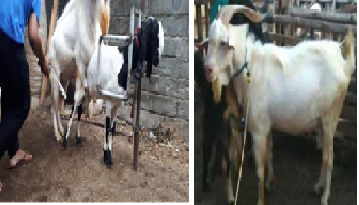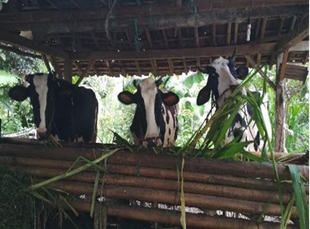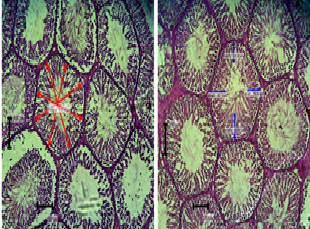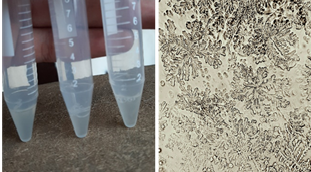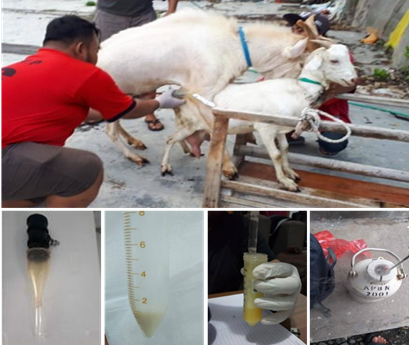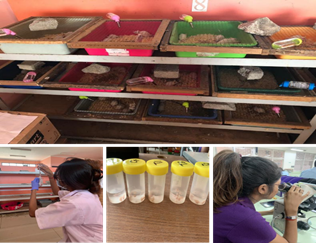Total protein, albumin, and globulin levels of blood serum in repeat breeder Holstein Friesian cows

Downloads
This study aimed to determine the relationship between total protein, albumin, and globulin in the blood with the incidence of repeat breeders in dairy cows. Ten normal cyclic cows and ten repeat breeders cows were taken randomly based on the reproductive records of the Tani Wilis Village Cooperative, Sendang District, Tulungagung Regency. Questionnaire data in the form of farmers' knowledge about dairy cows' reproductive systems and feed treatment is displayed descriptively. Dairy cows blood samples were taken from the jugular vein 6 mL to measure total protein, albumin, and globulin levels. Data analyzed using the Statistical Product and Service Solution software at a significance level of 5%. The results showed that the total protein, albumin, and globulin levels in normal dairy cows and dairy cows with repeat breeders were not significantly different (p>0.05). However, in normal cyclic cows, most of the total protein, albumin, and globulin levels (80-100% of normal cyclic cows samples) are within the normal range. Meanwhile, the majority of repeat breeder cows (60-70% of the repeat breeder cows) had total protein, albumin, and globulin levels lower than the normal range (p<0.05). It could be concluded that there was a relationship between the incidence of repeat breeder and total protein, albumin, and globulin levels in the blood serum of dairy cows with repeat breeder. Therefore, it is suggested to raise awareness of smallholder farmers about proper feeding and feeding management to reduce repeat breeder cases.
Ahammed R, Tasnim M, Halim MA, Sarkar M, Islam MS, Morshed. 2018. A Comparative study on reproductive hormones of repeat breeding and synchronized repeat breeding dairy cows under bathan rearing system at Baghabari milk shed areas in Bangladesh. IOSR J Agric Vet Sci. 11: 55-60.
Ahmed ME, Ahmed FO, Frah EAM, Imadeldin Elfaki I. 2017. Blood biochemical profile of Sudanese crossbred repeat breeder cows. Afr J Biotechnol. 16: 366-70.
Baker ME. 2002. Albumin, steroid hormones and the origin of vertebrates. J Endocrinol. 175: 121-7.
Barui A, Batabyal S, Ghosh S, Saha D, Chattopadhyay S. 2015. Plasma mineral profiles and hormonal activities of normal cycling and repeat breeding crossbred cows: A comparative study. Vet World 8: 42-5.
Bobbo T, Fiore E, Gianesella M, Morgante M, Gallo L, Ruegg PL, Bittante G, Cecchinato A. 2017. Variation in blood serum proteins and association with somatic cell count in dairy cattle from multi-breed herds. Animal 11: 2309-19.
Cattaneo L, Lopreiato V, Piccioli-Cappelli F, Trevisi E, Minuti A. 2021. Plasma albumin-to-globulin ratio before dry-off as a possible index of inflammatory status and performance in the subsequent lactation in dairy cows. J Dairy Sci. 104: 8228-42.
CMRI (Clinical Chemistry Reference Intervals). 2022. Veterinary Medical Teaching Hospital, University of California, Davis. 6 December 2022.
Dumadi EH, Abdullah L, Sukria HA. 2021. Quality of Napier grass forage (Pennisetum purpureum) with different growth type: Quantitative review. J Ilmu Nutrisi dan Teknologi Pakan 19: 6-13.
Erickson PS, Kalscheur KF. 2020. Nutrition and feeding of dairy cattle. Animal Agriculture. 2020: 157-80.
Eshete T, Demisse T, Yilma T, Tamir B. 2023. Repeat breeding and its associated risk factors in crossbred dairy cattle in Northern Central Highlands of Ethiopia. Vet Med Int. 2023: 1176924.
Gounden V, Vashisht R, Jialal I. 2022. Hypoalbuminemia. In: StatPearls [Internet]. StatPearls Publishing. USA. Updated 2022 Aug 29.
Hammond GL. 2016. Plasma steroid-binding proteins: primary gatekeepers of steroid hormone action. J Endocrinol. 230: 13-25.
Izza L, Ihsan M. 2023. Pemberdayaan masyarakat melalui pengelolaan sapi perah di Desa Geger Kecamatan Sendang Kabupaten Tulungagung. BHAKTI: Jurnal Pengabdian dan Pemberdayaan Masyarakat 2: 32-8.
Joye I. 2019. Protein digestibility of cereal products. Foods 8 :199.
Jung MY, Kang S, Lim D-H, Kim T-I, Lee K, Ha S. 2021. Serum biochemical profiles of repeat breeder holstein friesian cows. Korean J Vet Serv. 44: 239-46.
Khan MH, Manoj K, Pramod S. 2016. Reproductive disorders in dairy cattle under semi-intensive system of rearing in North-Eastern India, Vet World 9: 512-8.
Maulana R, Susetya H, Prihatno SA. 2022. Prevalence and risk factors associated with repeat breeding of beef cattle in Sleman Regency, Indonesia. Vet World 15: 870-7.
Moman RN, Gupta N, Varacallo M. 2022. Physiology, albumin. In: StatPearls [Internet]. StatPearls Publishing. USA. Updated 2022 Dec 26.
Nurdiyansah I, Suherman D, Putranto HD. 2020. Hubungan karakteristik peternak dengan skala kepemilikan sapi perah di kecamatan Kabawetan Kabupaten Kepahiang. Bul Pet Trop. 1: 64-72.
Padder S, Barson RK, Rahman MM, Bhuiyan MMU, Bhattacharjee J. 2018. Repeat breeding syndrome in crossbred dairy cows of Bangladesh: some important characteristics and influential factors. Bangl J Vet Med. 16: 183-91.
Pérez-Marín CC, Quintela LA. 2023. Current insights in the repeat breeder cow syndrome. Animals 13: 2187.
Pratama HS, Mustofa I, Lokapirnasari WP, Srianto P, Rimayanti R, Suzanita Utama S. 2019. Milk urea nitrogen (MUN) level on Holstein Friesian crossbreed based on different calving interval. Ovozoa 8: 1-4.
Sammad A, Wang YJ, Umer S, Lirong H, Khan I, Khan A, Ahmad B, Wang Y. 2020. Nutritional physiology and biochemistry of dairy cattle under the influence of heat stress: Consequences and opportunities. Animals (Basel) 10: 793.
Schwab CG, Broderick GA. 2017. A 100-year review: Protein and amino acid nutrition in dairy cows. J Dairy Sci. 100: 10094-10112.
Setyadi AW, Srianto P, Widodo OS, Wurlina W, Samik A, Restiadi TI. 2019. Percentage of repeat breeder evidence in dairy cows after artificial insemination at farmer level of KUD Tani Wilis in Nyawang Kidul, Sendang District, Tulungagung City. Ovozoa 8: 164-8.
Tadesse B, Reda AA, Kassaw NT, Tadeg W. 2022. Success rate of artificial insemination, reproductive performance and economic impact of failure of first service insemination: a retrospective study. BMC Vet Res. 18: 226.
Temesgen MY, Assen AA, Gizaw TT, Minalu BA, Mersha AY. 2022. Factors affecting calving to conception interval (days open) in dairy cows located at Dessie and Kombolcha towns, Ethiopia. PLoS One 17: e0264029.
Thasmi CN, Husnurrizal H, Akmal M, Wahyuni S, Siregar TN. 2021. The blood biochemical profile in Aceh cows with repeat breeding. J Veteriner 22: 26-32.
Thasmi CN, Siregar TN, Wahyuni S, Aliza D, Hamdan H, Panjaitan B, Asmilia N, Husnurrijal H. 2018. Steroid level of repeat breeding Aceh cattle synchronized with PGF2α. Proceeding of The 8 th AIC: Health and Life Sciences 2018 - Syiah Kuala University: 83-9.
Tothova C, Nagy O, Kovac G. 2016. Serum proteins and their diagnostic utility in veterinary medicine: A review. Veterinární Medicína 61: 475-96.
Widayati DT, Bintara S, Natawihardja I, Maharani D. 2018. Blood biochemical profile in fertile and repeat breeder Ongole cross breed cows. Pak J Biol Sci. 21: 166-70.
Widayati DT, Paramita MA, Dwiviyanti E, Suranindyah YY. 2019. Correlation between blood metabolite and reproductive performance of lactating Holstein Friesian crossbred cows in smallholder farmers. J Kedokteran Hewan 13: 1-4.
Xiao C, Wang J, Zhang C. 2023. Synthesis, regulatory factors, and signaling pathways of estrogen in the ovary. Reprod Sci. 30: 350-60.
Yaginuma H, Funeshima N, Tanikawa N, Miyamura M, Tsuchiya H, Noguchi T, Iwata H, Kuwayama T, Shirasuna K, Hamano S. 2019. Improvement of fertility in repeat breeder dairy cattle by embryo transfer following artificial insemination: possibility of interferon tau replenishment effect. J Reprod Dev. 65: 223-9.
Copyright (c) 2023 Siti Iqmallisa Nurrill Asrar, Rimayanti Rimayanti, Ismudiono Ismudiono, Maslichah Mafruchati, Gandul Atik Yuliani, Ginta Riady

This work is licensed under a Creative Commons Attribution-ShareAlike 4.0 International License.
Ovozoa by Unair is licensed under a Creative Commons Attribution-ShareAlike 4.0 International License.
1. The journal allows the author to hold the copyright of the article without restrictions.
2. The journal allows the author(s) to retain publishing rights without restrictions
3. The legal formal aspect of journal publication accessibility refers to Creative Commons Attribution Share-Alike (CC BY-SA).
4. The Creative Commons Attribution Share-Alike (CC BY-SA) license allows re-distribution and re-use of a licensed work on the conditions that the creator is appropriately credited and that any derivative work is made available under "the same, similar or a compatible license”. Other than the conditions mentioned above, the editorial board is not responsible for copyright violation.





























